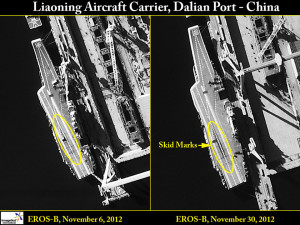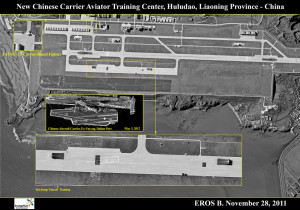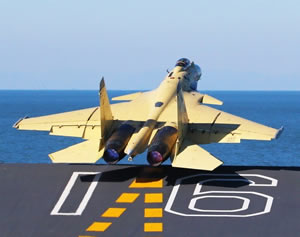
China’s Xinhua News Agency, commonly recognized as the nation’s official news service, announced on 25 November that a J-15 carrier-based fighter-bomber of the People’s Liberation Army Navy (PLAN) made a successful landing aboard the nation’s first aircraft carrier, the Liaoning. This landing represents the first known landing of a jet aircraft aboard China’s one and only aircraft carrier and marks a major stride forward in Beijing’s efforts to field a combat-capable aircraft carrier.
The Shenyang J-15 is a Chinese-built carrier-borne multi-role fighter-bomber based on Russia’s Sukhoi SU-33. The Xinhua News Agency claims that the J-15 is capable of carrying air-to-air, anti-ship, and air-to-ground missiles as well as an array of precision-guided munitions. According to Xinhua, the J-15’s performance is comparable to that of the Russian SU-33 and the American F-18.
In all, the Xinhua News Service reported that five J-15 fighters successfully landed aboard the Liaoning after conducting touch-and-go exercises on 4 November. Other news sources reported that a new two-seat J-15S completed its first test flight on 3 November.
According to the Xinhua News Service, this operation symbolizes the debut of the J-15 and claimed that the aircraft and ship demonstrated “good compatibility.” Xinhua also provided several undated high-resolution photographs of the landing and the Internet is now featuring several videos of the event as well.
A video broadcast by the China Central Television network clearly shows a J-15 landing on the Liaoning, dropping a tailhook, catching a deck-mounted arrestor cable, and slowly coasting to a halt.

After the successful landing, the aircraft is seen folding its wings and horizontal stabilizers as it taxis forward on the flight deck. Folding wings are crucial capability for aircraft operating within the restricting confines of an aircraft carrier. Additional video and photos also show a J-15 performing a successful take off from the carrier. Until now, many analysts were skeptical that China possessed the technical know-how to field an operational arrestor-cable system capable of withstanding the rigors of multiple carrier landings. Chinese pilots have been preparing for carrier operations for years. Particularly, pilots were trained on a land-based carrier mock-up runway built at the Chinese Carrier Aviator Center at Huludao, in the Liaoning provinde.
In addition to the international surprise expressed following the successful landings, many analysts were also taken aback by the appearance of a functioning arresting gear system aboard the Liaoning. Arresting gear technology is highly prized and closely guarded. Only a very few nations possess the technology to produce a functioning system and none of them have ever expressed the slightest willingness to share this technology. The question now being asked is how China was able to produce a functioning arresting-gear system in such a short time and seemingly without any previous experience in such a difficult engineering feat?
The Liaoning was initially laid down as the Admiral Kuznetsov-class multi-role aircraft carrier Riga in Mykolav, Ukraine in 1985 for the Soviet Navy and was formally launched in late 1988 and renamed the Varyag in 1990. Work on the ship was discontinued in 1992 at a time when the ship was structurally complete, but lacked electronics and other necessary equipment.
When the Soviet Union dissolved, ownership of the ship was transferred to the Ukraine. At this time she was laid up, stripped of most vital equipment, and allowed to languish with no maintenance being performed. By 1998, she was little more than a hulk lacking engines, without a rudder or required onboard operating systems, and in a deplorable state of disrepair.
The ship was bought from the Ukraine in 1998 for $20 million by a Chinese firm ostensibly for the purpose of transforming her into a floating hotel and tourist attraction. After being towed to the Dalian Shipyard in northeastern China, she underwent an extensive refit and emerged in 2006 in the form of a PLAN aircraft carrier. The Liaoning was formally inducted into the PLAN in September 2012. This event marked China’s first foray into the rarified world of aircraft carrier operations, a highly complex endeavor mastered by only a handful of nations. Only five other nations are presently able to deploy full-size aircraft carriers capable of conducting sustained fixed-wing flight operations.
In its present configuration, Liaoning is believed to be capable of operating an air wing of 30 fixed-wing aircraft and as many as 24 rotary-wing aircraft.
A cursory glance at the new J-15 leaves little doubt that the aircraft is a close copy of the Russian Sukhoi-33. Negotiations between Russia and China for the sale of an undisclosed number of SU-33s for use by the PLAN collapsed in 2009 as a result of Russian concerns that China intended to reverse-engineer the aircraft and produce a domestically-manufactured clone. Unfortunately for the Russians, China was able to obtain an SU-33 prototype from the Ukraine and now we have an operational Chinese J-15.
Chinese representatives have adamantly denied that the J-15 is an SU-33 clone. While China admits the J-15’s airframe is similar to that of the SU-33, Xinhua claims that the J-15 is the result of Chinese ingenuity and innovation.
With the PLAN’s first carrier landings and take-offs, China has taken a critical step forward in its efforts to develop a credible naval force able to project Chinese power far beyond its own shores – a “blue-water” Navy so to speak. Although this latest development does not, by any means, indicate that China is now prepared to carry out full-scale naval operations combining all elements of a “traditional” carrier strike group, it does represent a significant step in that direction. Carrier-borne operations combine some of the most complex seaborne activities known to man with intricate shipboard maneuvers that sometimes seem to move with lightning speed and China still has much to learn before she will be able to deploy a combat-ready carrier strike force.
As a side note, the China-based SINA website reported that Luo Yang, the senior engineer in charge of research and development of the J-15, died suddenly of a heart attack while aboard the Liaoning for the test flight operations. Yang was chairman and general manager of AVIC Shenyang Aircraft Corporation and devoted most of his time to the development of the J-15 according to SINA.
[wzslider info=”true”]

















